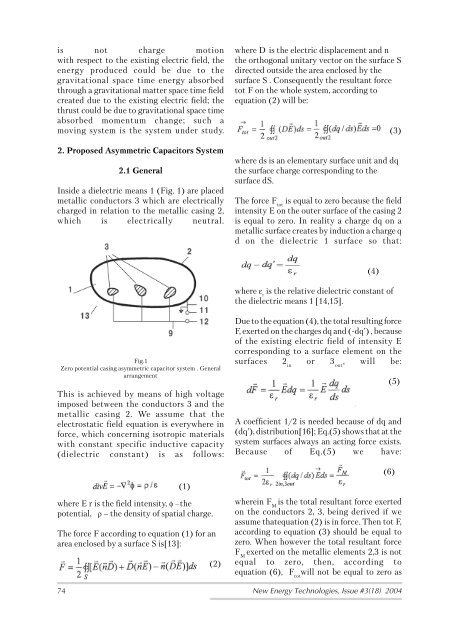Issue 17 - Free-Energy Devices
Issue 17 - Free-Energy Devices
Issue 17 - Free-Energy Devices
Create successful ePaper yourself
Turn your PDF publications into a flip-book with our unique Google optimized e-Paper software.
is not charge motion<br />
with respect to the existing electric field, the<br />
energy produced could be due to the<br />
gravitational space time energy absorbed<br />
through a gravitational matter space time field<br />
created due to the existing electric field; the<br />
thrust could be due to gravitational space time<br />
absorbed momentum change; such a<br />
moving system is the system under study.<br />
2. Proposed Asymmetric Capacitors System<br />
2.1 General<br />
Inside a dielectric means 1 (Fig. 1) are placed<br />
metallic conductors 3 which are electrically<br />
charged in relation to the metallic casing 2,<br />
which is electrically neutral.<br />
Fig.1<br />
Zero potential casing asymmetric capacitor system . General<br />
arrangement<br />
This is achieved by means of high voltage<br />
imposed between the conductors 3 and the<br />
metallic casing 2. We assume that the<br />
electrostatic field equation is everywhere in<br />
force, which concerning isotropic materials<br />
with constant specific inductive capacity<br />
(dielectric constant) is as follows:<br />
(1)<br />
where E r is the field intensity, φ –the<br />
potential, ρ − the density of spatial charge.<br />
The force F according to equation (1) for an<br />
area enclosed by a surface S is[13]:<br />
(2)<br />
where D is the electric displacement and n<br />
the orthogonal unitary vector on the surface S<br />
directed outside the area enclosed by the<br />
surface S . Consequently the resultant force<br />
tot F on the whole system, according to<br />
equation (2) will be:<br />
74 New <strong>Energy</strong> Technologies, <strong>Issue</strong> #3(18) 2004<br />
(3)<br />
where ds is an elementary surface unit and dq<br />
the surface charge corresponding to the<br />
surface dS.<br />
The force F tot is equal to zero because the field<br />
intensity E on the outer surface of the casing 2<br />
is equal to zero. In reality a charge dq on a<br />
metallic surface creates by induction a charge q<br />
d on the dielectric 1 surface so that:<br />
(4)<br />
where ε r is the relative dielectric constant of<br />
the dielectric means 1 [14,15].<br />
Due to the equation (4), the total resulting force<br />
F, exerted on the charges dq and (-dq’) , because<br />
of the existing electric field of intensity E<br />
corresponding to a surface element on the<br />
surfaces 2 in or 3 out , will be:<br />
(5)<br />
A coefficient 1/2 is needed because of dq and<br />
(dq’), distribution[16]; Eq.(5) shows that at the<br />
system surfaces always an acting force exists.<br />
Because of Eq.(5) we have:<br />
(6)<br />
wherein F M is the total resultant force exerted<br />
on the conductors 2, 3, being derived if we<br />
assume thatequation (2) is in force. Then tot F,<br />
according to equation (3) should be equal to<br />
zero. When however the total resultant force<br />
F M exerted on the metallic elements 2,3 is not<br />
equal to zero, then, according to<br />
equation (6), F tot will not be equal to zero as
















